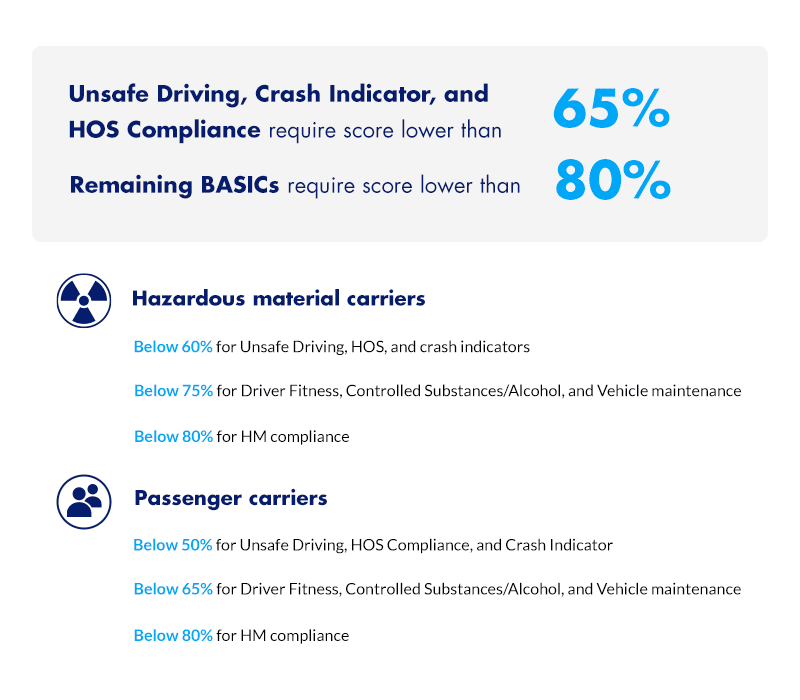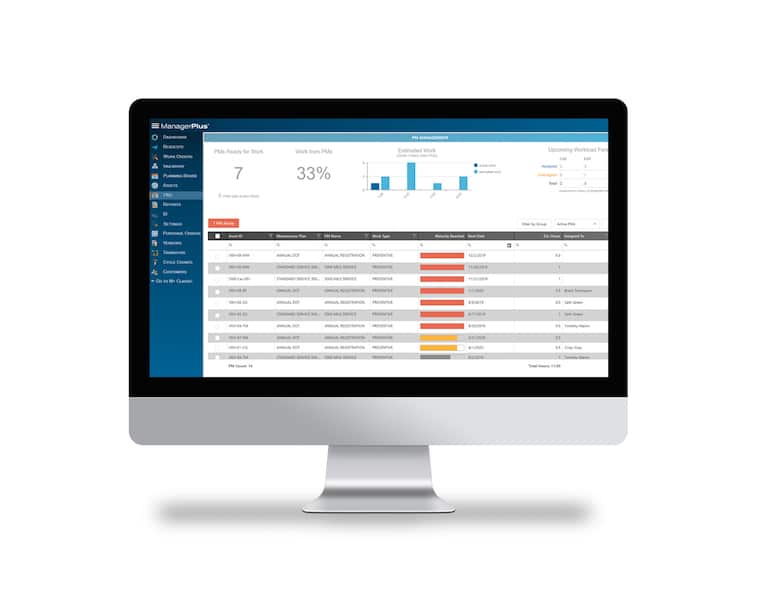The CSA score is one of the most fundamental metrics used by federal regulators to monitor commercial fleets, helping to ensure both professional and civil drivers are protected out on the roads.
There’s a lot involved with your CSA score, but trying to keep track of it all doesn’t have to be intimidating.
Let’s look a little more at what a CSA score really is and how you can improve and maintain your ranking.
There’s a lot to think about when managing a fleet, ranging from driver schedules to vehicle maintenance. One of the most important, and potentially most complicated, is all the government regulations.
What is a CSA score?
CSA is a program run by the Federal Motor Carrier Safety Administration (FMCSA) designed to enforce safety measures for both drivers and owner-operators. If you have a DOT number, you have a CSA score chart.
CSA stands for Compliance, Safety, and Accountability, and your CSA score matters. The score is measured on a scale from 0 – 100, and the lower the score, the better.
All the data for your CSA score is stored in a database called the Safety Measurement System (SMS). This centralized set of data is what the FMCSA uses to determine your CSA score.
The agency gathers data from roadside inspections and crash reports going back two years as well as data from investigations it conducts to determine your score.
Each company’s “score” is a percentage calculated from points awarded under each category of the seven Behavior Analysis and Safety Improvement Categories (BASICs).
They are:
- Unsafe driving
- Crash indicator
- HOS compliance
- Vehicle maintenance
- Controlled substances/alcohol
- Hazardous materials compliance
- Driver fitness
Let’s look at each one a bit more closely.

Unsafe driving
This one is mostly common sense, and falls under what most anyone would consider unsafe driving. Things like texting, speeding, distracted driving, etc. Basically, anything that diverts your eyes and/or attention away from the road.
Crash indicator
Your carrier’s state-reported crash data from the past two years is used to calculate this score. The idea is to identify patterns of high crash rates and the behaviors that attributed to the crash. Crashes are reported if they result in fatality or injury, or if one of the vehicles involved had to be transported from the crash scene, regardless of the carrier or driver’s role in the accident.
This information is not available to the public so only people at your carrier with appropriate login information can access this score.
HOS compliance
HOS or hours-of-service compliance relates to the rules regarding drive-time for each driver. These are update fairly regularly and are important to your CSA score, so it’s a good to make sure you and your drivers are up to date on them.
Vehicle maintenance
Proper vehicle maintenance is not only important to achieving a low CSA score, but also vitally important for optimizing your vehicles and assets to keep them running longer. Implementing a strong asset management platform for your fleet can help reduce your costs while helping you ensure compliance and maintain a low CSA score.
Controlled substances/alcohol
This is also a fairly straight-forward metric. Any misuse of alcohol, illegal, prescription, or even over-the-counter drugs that impair a driver’s ability increase your score. Any container of alcohol, whether open or not, is considered a violation.
Hazardous materials compliance
This BASIC covers regulations regarding the transporting of hazardous materials. You can be penalized for improper packaging, labeling, placards, loading, and a few other items. The information for this one is also not public. Only people in your organization with appropriate login credentials can access the information.
Driver fitness
The driver fitness BASIC concerns the records you have for each driver. Your company is scored on how up to date your driver qualifications and certifications are, including driving records.
What is a bad CSA score?
A carrier’s CSA score is calculated as a percentage with a 100% being the worst possible score, so you want a low number. Each BASIC category has a different percentage requirement to stay below to avoid an intervention.

Unsafe Driving, Crash Indicator, and HOS Compliance all require a score lower than 65% while the remaining BASICs require an 80% or lower.
Hazardous material carriers must maintain below 60% for Unsafe Driving, HOS, and crash indicators and below 75% for Driver Fitness, Controlled Substances/Alcohol, and Vehicle maintenance. HM compliance requires an 80% or lower.
For passenger carriers, Unsafe Driving, HOS Compliance, and Crash Indicator must stay below 50%, Driver Fitness, Controlled Substances/Alcohol and vehicle maintenance must stay below 65%. HM compliance must stay below 80%.
If your score gets too high, the FMCSA intervenes. These interventions can include any of the following:
- Warning letter
- Increased roadside enforcement
- Focused off-site investigation
- Focused on-site investigation
- Cooperative safety plan
- Notice of violation
- Comprehensive on-site investigation
- Notice of claim, penalty, and settlement agreement
Now, of all of these, only the last one seems like an actual penalty with fines. However, many of the downsides to a bad CSA score come in the form of delays and loss of reputation.
A Safety Investigator won’t revoke a CDL for a high CSA, but you should not underestimate the delays and damages.
The Cooperative safety plan is usually the follow-up to an investigation and requires you to take even more time to figure out how to improve your performance. For your drivers, Increase Roadside Enforcement can add hours to their downtime as they must be submitted to DOT inspections while on the road.
None of this even looks at the effects that a low CSA score for trucks has on your clients. CSA scores are a matter of public record, and your clients can use them to compare you with your competition. If your truck’s CSA score is too high, you could lose clients to other companies with better safety records.

What is a good CSA score?
Anything below the required thresholds mentioned above classifies as a good CSA score but remember, the lower the better. Anything you can do to lower your score and keep it low is great.
Do drivers have a CSA score?
CSA scores only apply to carriers as they assigned based on a company’s DOT number. Any violation a driver receives is counted towards the carrier, not the driver themselves.
Drivers have their own violation and scoring system called the Pre-employment Screening Program (PSP) which is a voluntary program containing information on crash and roadside inspection history. Crash data goes back five years and roadside inspection data for the past three years may be requested by any carrier prior to hiring a driver.
Driver’s must give written consent before a carrier may access their PSP information during the pre-employment screening.
How can I look up or calculate a CSA score?
All publicly available data regarding CSA scores for any carrier with a DOT number can be found on the CSA website. Simply type in your carrier’s name or DOT number to pull up the information. Only the data for the Crash Indicator and Hazardous Materials Compliance is not available to the public. To access that information, you must set up a unique login and pin with the FMCSA as an approved user for your organization. If you don’t already have a login, you can register for one online.
There’s lots data involved in calculating a CSA score, but the frequency of violations also has an impact. Violations for drivers are multiplied based on how recently it occurred.
- Violations within 12-24 months are counted once.
- Violations within 6-12 months are multiplied by 2
- Violations within 0-6 months are multiplied by 3
How can I improve a CSA score?
CSA scores are not permanent and can be improved over time. The more your carrier and your drivers adopt a culture of safety, the better your lower your CSA score . Understanding what the BASICs are and what factors affect your score can help your drivers avoid violations.
In 2018, the FMCSA implemented its Electronic Logging Device (ELD) mandate which requires all driver logs to be stored and tracked electronically. Using a cloud-based fleet management software can help your drivers keep track of their logs and inspections so you always have them whenever you need them.
One of the most heavily weighted BASICs on which your carrier’s CSA score depends is the Vehicle Maintenance BASIC. Points here come from a failure to properly maintain a Commercial Motor Vehicle (CMV) and prevent shifting loads, spilled or dropped cargo, and overloading.
A powerful fleet maintenance software as part of an enterprise asset management (EAM) solution like ManagePlus can help. When you track all your work orders, you have a comprehensive record that can demonstrate all your preventive maintenance and corrective efforts to keep your assets in top working condition. PM work orders can be triggered automatically based on time or condition of certain assets and can immediately notify your technician to ensure not critical maintenance is missed.

Keeping track of your inspections can also help out with the Hazardous Materials Compliance BASIC. This BASIC gives points for unsafe handling of Hazardous Materials. If you are diligent in your inspections to make sure you are safe, ManagerPlus can back you up with documentation.
ManagerPlus can also help you to track your employee training and certifications, which falls under the Driver Fitness BASIC. This BASIC gives points for operation of CMVs by drivers who are unfit to operate a CMV due to lack of training, experience, or medical qualifications. All training and certifications can be tracked, including expiration dates so you know when it’s time to retrain or get new certifications.
Keep your organization’s CSA score low with Lightning from ManagerPlus. With all your updated inspection records in one easy-to-access database, you can stay on top of your preventive maintenance program and ensure all of your drivers are up to date on their training and certifications.
Take control of your CSA score with ManagerPlus. Schedule a demo with us today.
